Flick through your mental catalog of sporty retro machines for a moment. Depending on your bent, you might think of the Triumph Bonneville as the midpoint, the center of gravity for this group. And you’d be right, since the Trumpet has been a phenomenal success. You can’t roll past a craft-brew supply shop without seeing half a dozen out front. You’ll think Sportster, too. The Bonnie and the Sporty are two massively popular machines, stacked up like PBR empties behind the bowling alley.
To this list you should add the Moto Guzzi V7 Racer, if for no other reason than it looks fantastic. That chrome tank bedazzled with a pair of leather straps, the deep ruby frame color, and the aluminum-hued side covers create a classic, compelling profile. From the mini headlight shroud to the number-plate seat cover, Guzzi got the Racer's styling exactly, perfectly right. It's a 10 out of 10.
Settle onto the suede seat, reach for the not-too-low clip-ons, punch the starter. An engine dating back to 1977 twists sideways and settles into a slightly irregular idle. (Our testbike, like the previous V7 we tested, was painfully cold blooded.) Sitting there in your driveway, Guzzi warming under you, the day is full of promise. Although it’s not especially light at 440 pounds (wet), the V7 comes off the sidestand and balances under you like a much more svelte machine. Catch your reflection in the tank, consider the handsome instruments, and think you’re so smart.
How long that smile lasts depends on what you expect from the Guzzi. While many bikes in this category are less-than-sterling performers—the Sportster is impossibly heavy and still a tick or three short on refinement while the Bonnie is very soft and reserved in stock form—the Guzzi trails the pack. Dynamically, the V7 Racer isn’t too far removed from its 1977 roots: The shift linkage has a vagueness that leaves you wondering if you really got first, the dry clutch’s take-up point is almost indiscernible—except, well, that you’re moving—and the low-speed throttle response is soggy, though we did not stall the Racer nearly as often as we did the Stone we had awhile back.
In the urban environment, the V7 is friendly once you become accustomed to its quirks. Although it looks sporty, the riding position is a great compromise between in-town comfort and sufficient forward lean to make short highway jaunts enjoyable. Legroom might be tight for some. And while it has “Racer” in the name, the V7 does not have racer in its soul: Unbalanced suspension (too soft up front, a bit stiff in the rear), barely adequate brakes, and slow steering all tell you so. Oh, yes, and there’s the matter of the V7’s 40.9 rear-wheel horsepower. Best not to challenge too many Bonnie riders then.
Matter of fact, the Bonneville-based Thruxton is the V7 Racer’s biggest problem—cheaper, bigger, faster, though considerably heavier. There’s nearly $1,400 of daylight between the Triumph and the $10,490 V7 Racer. Sure, that’s a chunk of change just to be unlike the half zillion or so Bonnie Boys ruling the night, but maybe that’s a motivation without budget limitations. Your call.










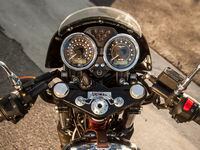


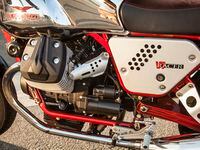
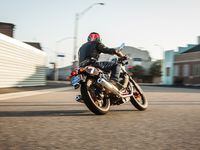
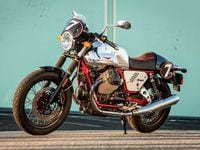
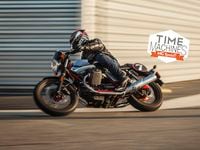
/cloudfront-us-east-1.images.arcpublishing.com/octane/MUQLOVLL2ZDGFH25ILABNBXKTI.jpg)
/cloudfront-us-east-1.images.arcpublishing.com/octane/TNOU5DNE2BC57MFPMGN2EIDXAM.jpg)
/cloudfront-us-east-1.images.arcpublishing.com/octane/GTCXACQGJ5HAPDTGWUQKDEH44E.jpg)
/cloudfront-us-east-1.images.arcpublishing.com/octane/S35YGSEMEZB4BLTDJTSZPF4GLA.jpg)
/cloudfront-us-east-1.images.arcpublishing.com/octane/5UOT6HPX2JFMRJAX6EH45AR4MQ.jpg)
/cloudfront-us-east-1.images.arcpublishing.com/octane/OKWOJWAKP5EP3OACCRRWPCIX2Q.jpg)
/cloudfront-us-east-1.images.arcpublishing.com/octane/2WF3SCE3NFBQXLDNJM7KMXA45E.jpg)
/cloudfront-us-east-1.images.arcpublishing.com/octane/G4MG6OUCJNBSHIS2MVVOTPX65E.jpg)
/cloudfront-us-east-1.images.arcpublishing.com/octane/IIGGWFOTOJGB7DB6DGBXCCMTDY.jpg)
/cloudfront-us-east-1.images.arcpublishing.com/octane/QSTCM6AVEZA5JJBUXNIQ3DSOF4.jpg)
/cloudfront-us-east-1.images.arcpublishing.com/octane/U4I7G625B5DMLF2DVIJDFZVV6M.jpg)
/cloudfront-us-east-1.images.arcpublishing.com/octane/B6XD6LS6IVCQPIU6HXDJSM3FHY.jpg)
/cloudfront-us-east-1.images.arcpublishing.com/octane/ICL63FEDDRDTTMINYICCEYGMDA.jpg)
/cloudfront-us-east-1.images.arcpublishing.com/octane/FCGZHQXRBZFLBAPC5SDIQLVF4I.jpg)
/cloudfront-us-east-1.images.arcpublishing.com/octane/WNOB6LDOIFFHJKPSVIWDYUGOPM.jpg)

/cloudfront-us-east-1.images.arcpublishing.com/octane/X33NU3E525ECRHXLNUJN2FTRKI.jpg)
/cloudfront-us-east-1.images.arcpublishing.com/octane/6KKT5NNL2JAVBOXMZYS5ZO76YA.jpg)
/cloudfront-us-east-1.images.arcpublishing.com/octane/J5RKG5O455GMPGQRF2OG6LRT7A.jpg)
/cloudfront-us-east-1.images.arcpublishing.com/octane/GX2CIZKQVRH2TATDM26KFG2DAE.jpg)
/cloudfront-us-east-1.images.arcpublishing.com/octane/ZWIDYSAKQZHD5BHREMQILXJCGM.jpg)
/cloudfront-us-east-1.images.arcpublishing.com/octane/CYUHJZCTSJCH3MRAQEIKXK7SCQ.jpg)
/cloudfront-us-east-1.images.arcpublishing.com/octane/LKOFINY56FCXJCANJ5M7ZDQUBY.jpg)
/cloudfront-us-east-1.images.arcpublishing.com/octane/4NBPDACMWJH63JQYJVK3QRBDZI.jpg)